This post contains affiliate links. Please see our disclosure policy.
Flexibility is key to feeling strong, mobile, and energized at any age. As we get older, maintaining a regular stretching routine becomes even more essential to improve flexibility, support joint health, prevent stiffness, and reduce the risk of injury.
Whether you’re in your 40s, 60s, or beyond, incorporating stretches into your daily routine can make a world of difference in how you move and feel.
You’ll enjoy health benefits far beyond better flexibility, like:
- Improves your performance in physical activities and everyday tasks
- Decreases your risk of injury
- Helps relieve and prevent upper and lower back pain
- Improves posture
- Gives a more youthful appearance (think shuffling or hunching over!)
Below I’m giving you 10 effective flexibility stretches that anyone can do to improve flexibility, regardless of experience or age.
Each stretch is designed to improve flexibility in a gentle yet effective way, so you can ease into them at your own pace and reap the benefits over time. Ready to loosen up?
Flexibility Stretch Routine Instructions
- Try each of the below stretches, holding for about 30 at a time and then take a deep breath and repeat. (Perform on each side if unilateral).
- Make sure to breathe slowly and relax as much as possible. Do not stretch to the point of pain.
1. Standing Side Bend
The standing side bend stretches the obliques, lats, and intercostal muscles along the sides of your torso, and improves flexibility through your entire side body. This stretch also encourages better posture by opening up the spine and helps release tension from your lower back.
For even more help standing taller, try these posture exercises!
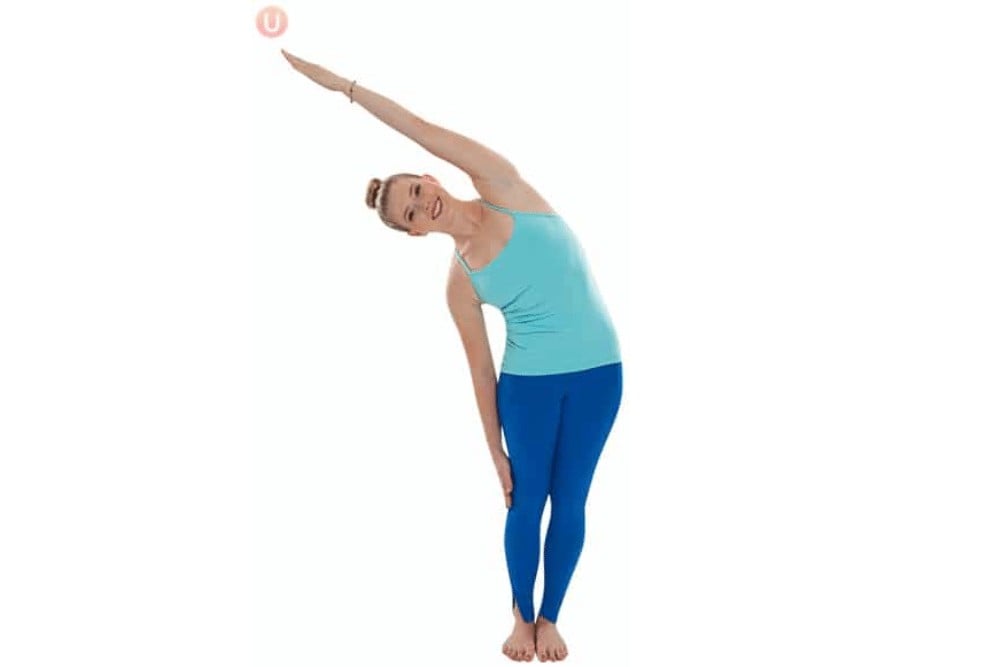
How to Perform a Standing Side Bend
- Stand tall with feet and legs together and reach both arms straight up overhead as you inhale.
- Lower your right arm down the right side of your body and exhale as you lengthen the left arm over the head, bending body gently to the right.
- Inhale to return arms overhead to center and exhale as you repeat on the left side.
2. Pyramid Pose
This deep hamstring and calf stretch lengthens the muscles at the back of your legs, promoting greater flexibility and mobility in your hips and hamstrings. Pyramid pose also stretches the lower back and helps enhance balance and stability.
I also recommend adding these balance exercises for seniors to your weekly routine!
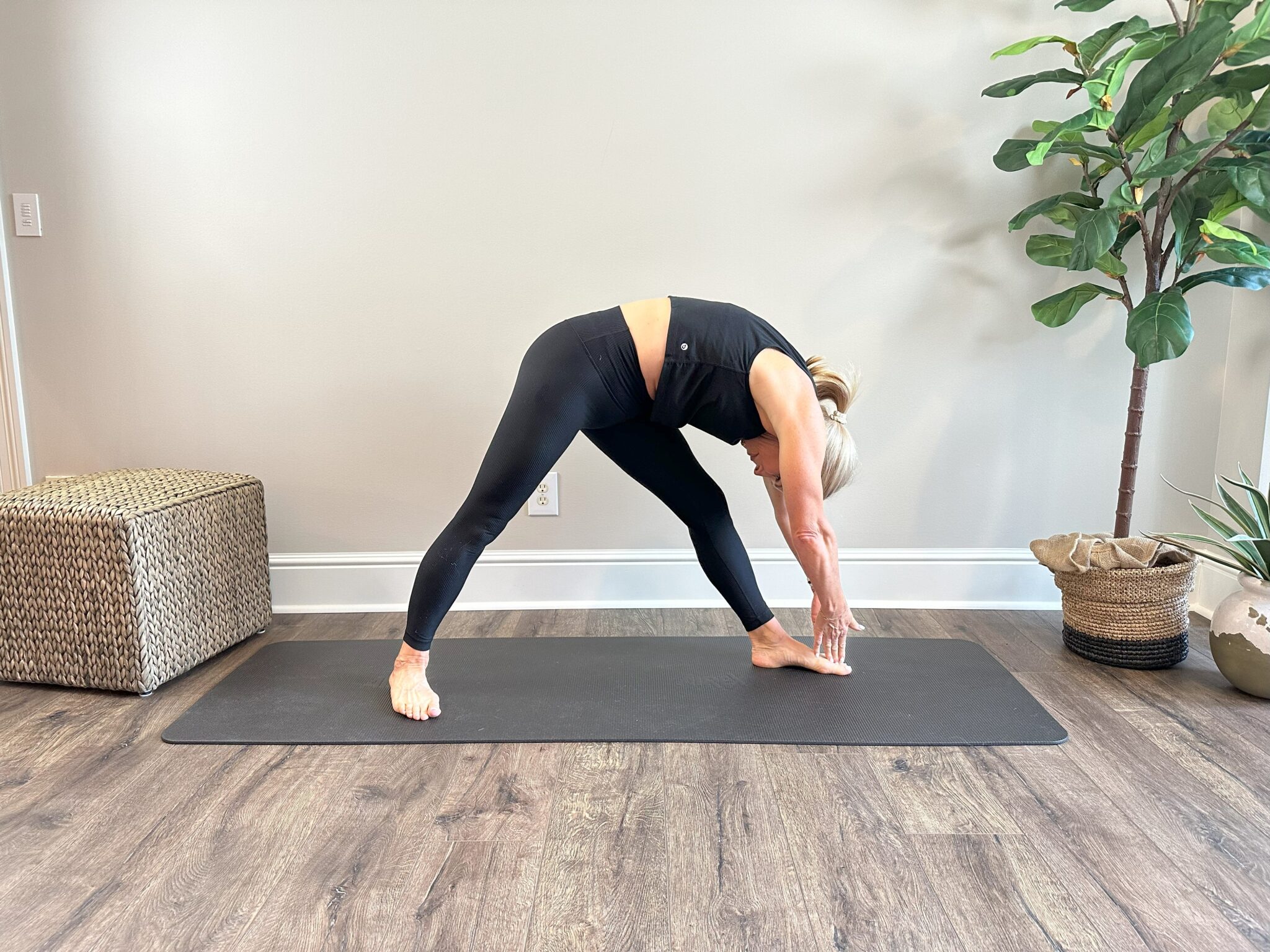
How to Perform Pyramid Pose
- From a standing position, step the inside of your left foot directly behind your right foot about 6-8 inches, as if you are standing on a balance beam. Back foot is angled.
- As you inhale reach both arms high overhead, lengthening your spine.
- As you exhale slowly reach hands down to shin or, if you are able, the floor. You can slightly bend the front knee if needed.
- Let your chest rest over your front leg and relax the back of your neck. Breath slowly as you stretch your hamstring.
- Hold 30 seconds and switch sides.
3. Yogi Squat
The yogi squat opens up the hips, inner thighs, and groin, helping to increase hip flexibility, which is essential for a full range of motion in everyday movements. This stretch also improves strength and stability in the lower body.
There are countless benefits of adding deep squat variations to your workout routine for improved mobility!
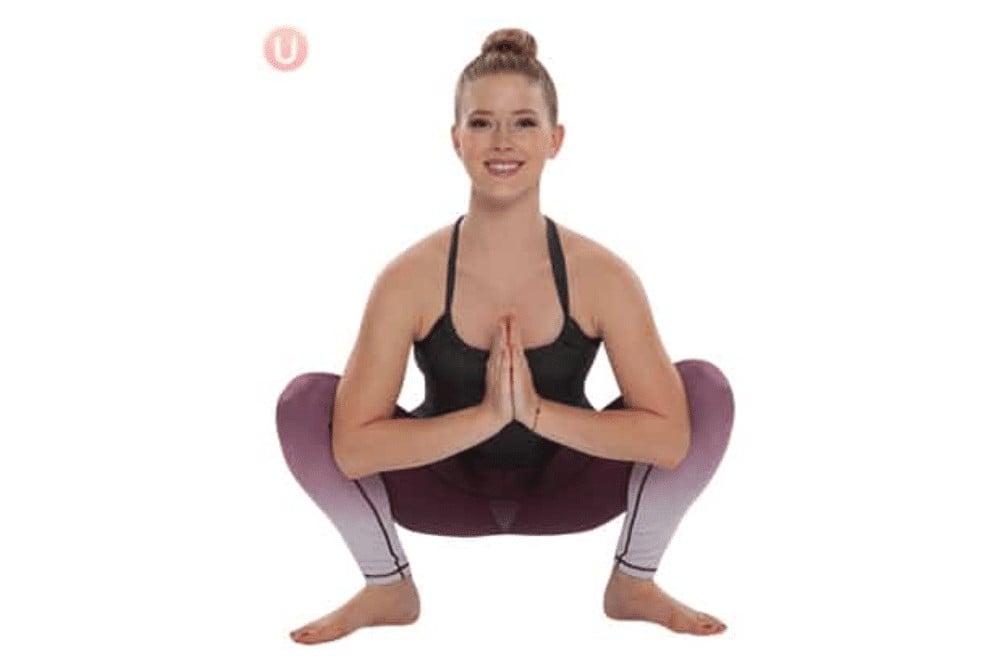
How to Perform a Yogi Squat
- Start with your feet slightly wider than shoulder distance apart and your toes turned out.
- Bend your knees and use your leg muscles to slowly lower your hips to the floor. Go as deep as you can while keeping your heels on the floor.
- Elbows pressing into knees and knees hugging into elbows the upper and lower body stay active.
- Straighten legs to return to standing.
4. Downward Dog
A staple yoga pose, downward dog stretches the hamstrings, calves, and shoulders, while lengthening and decompressing the spine. This pose supports overall flexibility, particularly in the back and legs, and can help ease tension throughout the body.
For even more leg relief, check out my favorite leg stretches for tight muscles!

How to Perform Downward Dog
- Begin in a kneeling position on your mat with hands directly under shoulders, fingers spread wide.
- Tuck your toes under and engage your abdominals as you push your body up off the mat so only your hands and feet are on the mat.
- Press through your hands moving your chest gently toward your thighs and your heels gently toward the floor.
- Relax your head and neck and breathe fully.
5. Cat Pose
This gentle spine stretch increases flexibility in the back, releasing tension from the spine and helping to mobilize each vertebra. It’s an excellent warm-up pose for improving overall spinal flexibility.
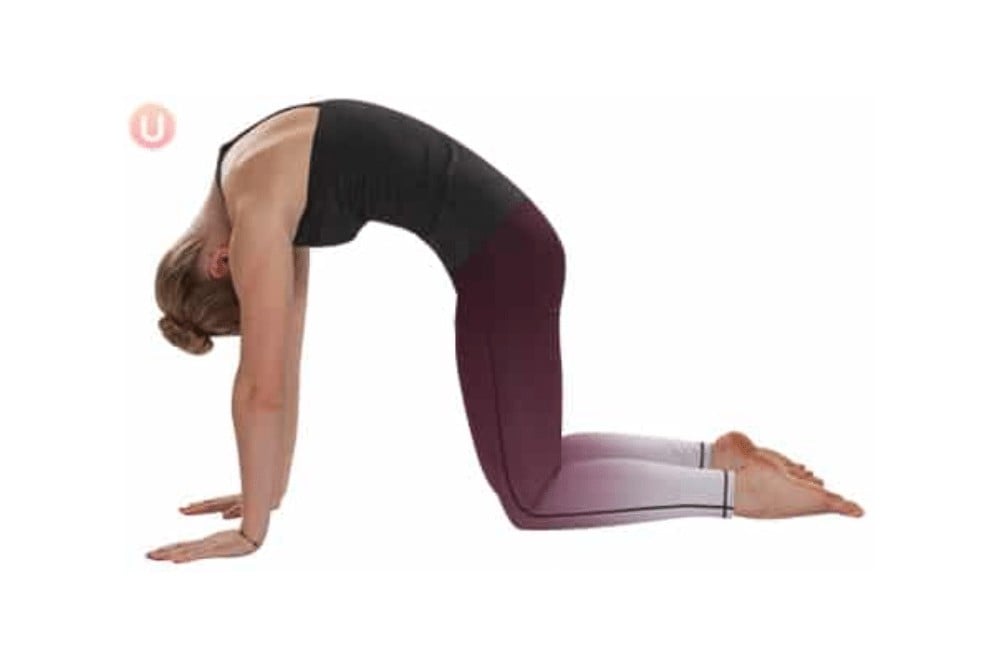
How to Perform Cat Pose
- Begin on your hands and knees with hands directly under shoulders and knees directly under hips.
- Start with your spine in a “neutral” or long position, then slowly tuck your tailbone and lower the crown of your head so your back gently rounds.
- Draw your naval up to your spine and breathe gently as you hold the stretch.
6. Cow Pose
Paired with cat pose, cow pose enhances flexibility in the back and neck. It also stretches the chest and helps improve posture by counteracting forward rounding in the shoulders.
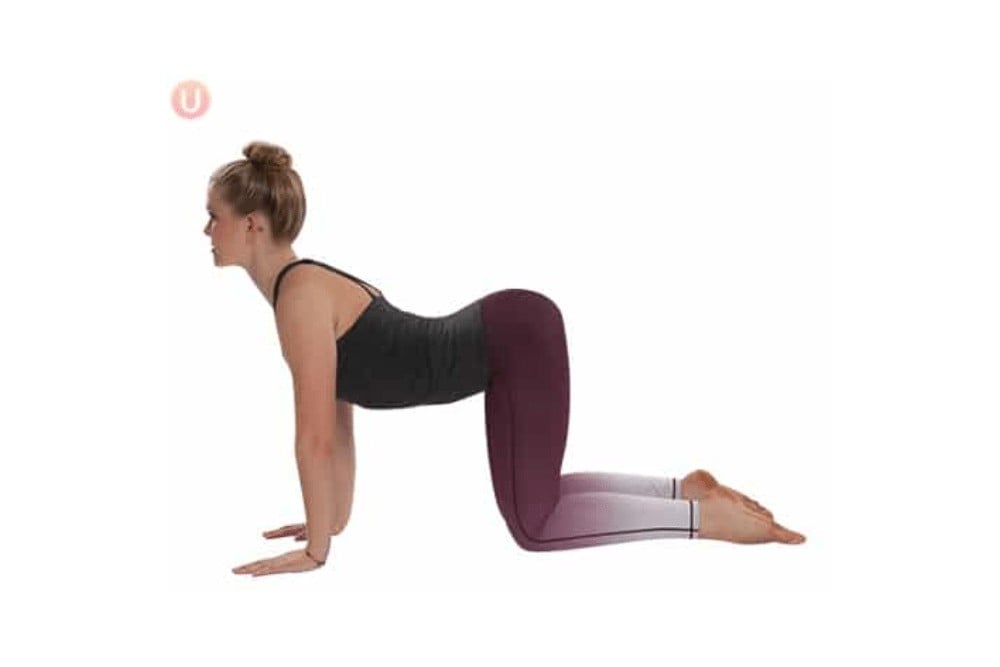
How to Perform Cow Pose
- Begin on your hands and knees with hands directly under shoulders and knees directly under hips.
- Start with your spine in a “neutral” or long position, then gently lift your heart and tailbone so your back gently curves downward. Be sure to focus on the lifting – do not press your back downward. Let the curve happen naturally.
- Look slightly upward with a relaxed neck and breathe gently.
7. Runner’s Lunge
This deep lunge stretches the hip flexors, quads, and hamstrings, promoting hip flexibility and range of motion. It’s particularly beneficial for those who sit for extended periods, helping to open up tight hips.
If hips are your problem area, you might also benefit from these resources!
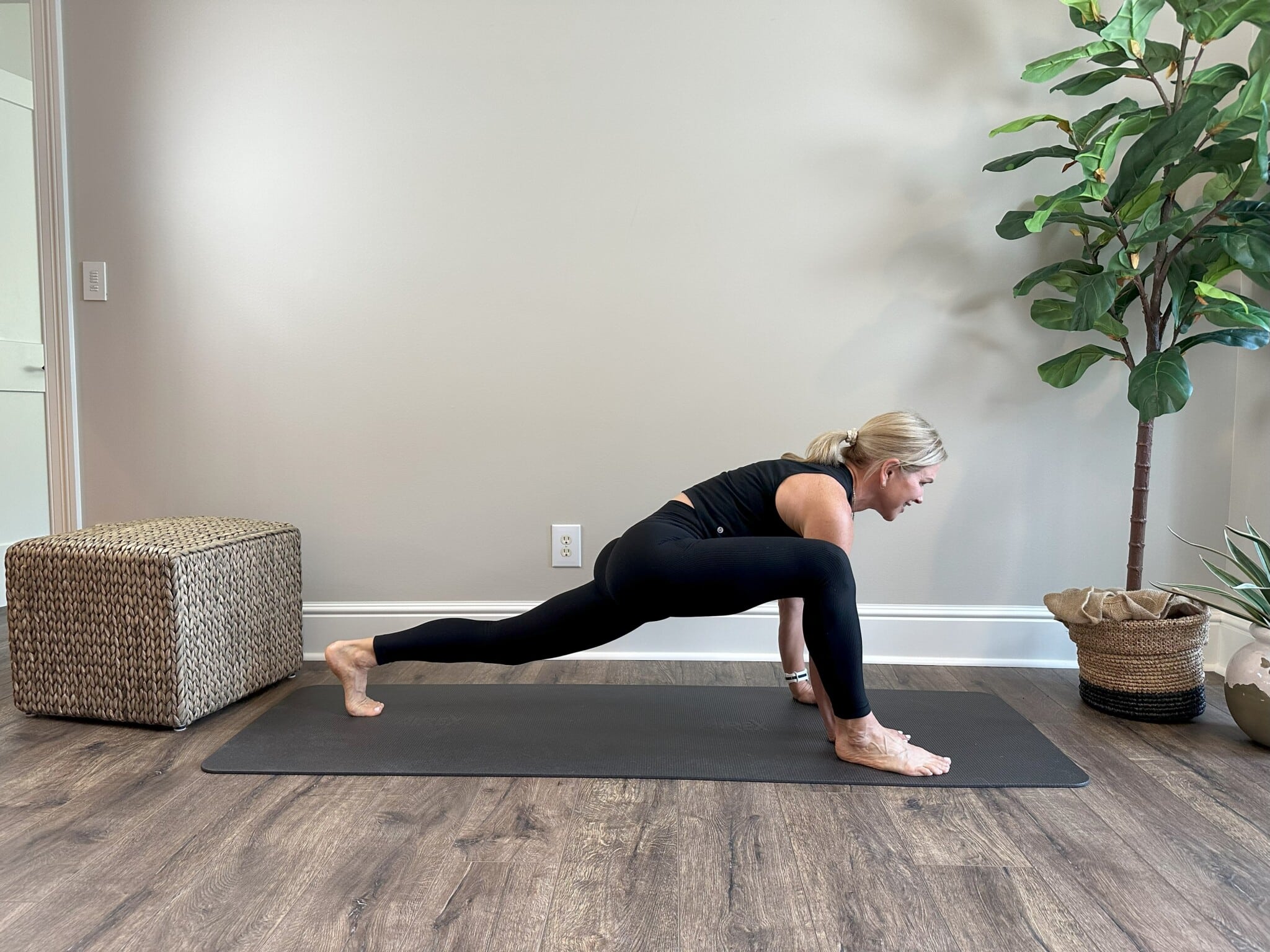
How to Perform a Runner’s Lunge
- Begin in a plank position with hands directly below shoulders.
- Step your right foot forward to the outer edge of your mat next to your right pinky finger.
- Relax through your hips and back, letting them sink toward the ground.
- Breathe and hold for 30 seconds. Switch sides.
8. Pigeon Pose
One of the best hip openers, pigeon pose stretches the glutes and the deep hip rotator muscles. It also improves flexibility in the hips, which can relieve lower back pain and help with activities requiring hip mobility.
If the back is your problem area, you can also give these back pain exercises a try!

How to Perform Pigeon Pose
- Begin in a plank position. Tighten your abdominals and pull your right knee toward your right hand placing your right foot as close to your left hand as you can.
- Keep your back leg long and keep your hips even as you relax your weight through the middle of your hips.
- Breathe and hold for 30 seconds. Step back into plank and switch sides.
9. Reverse Table Top Pose
This table top pose stretches the shoulders, chest, and hip flexors, counteracting forward rounding of the shoulders and promoting a strong, open posture. It also improves flexibility through the upper body and strengthens the glutes and back.
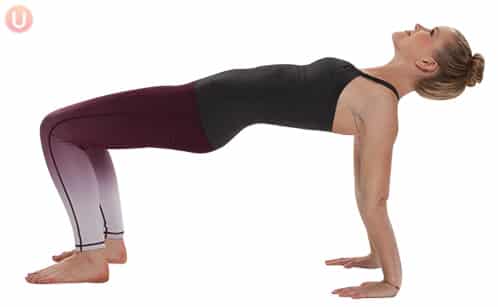
How to Perform Table Top Pose
- Begin in a seated position with feet flat on floor in line with sits bones.
- Place palms open on floor behind your back with fingers facing in.
- Look up and as you squeeze your abs and glutes, lift body upward while gently letting your head relax back.
- Breathe and hold 30 seconds.
10. Happy Baby Pose
This relaxing stretch gently opens the hips, inner thighs, and lower back, promoting a greater range of motion in the hips. Happy baby pose also helps release tension in the lower back, making it a perfect end to any stretching routine.
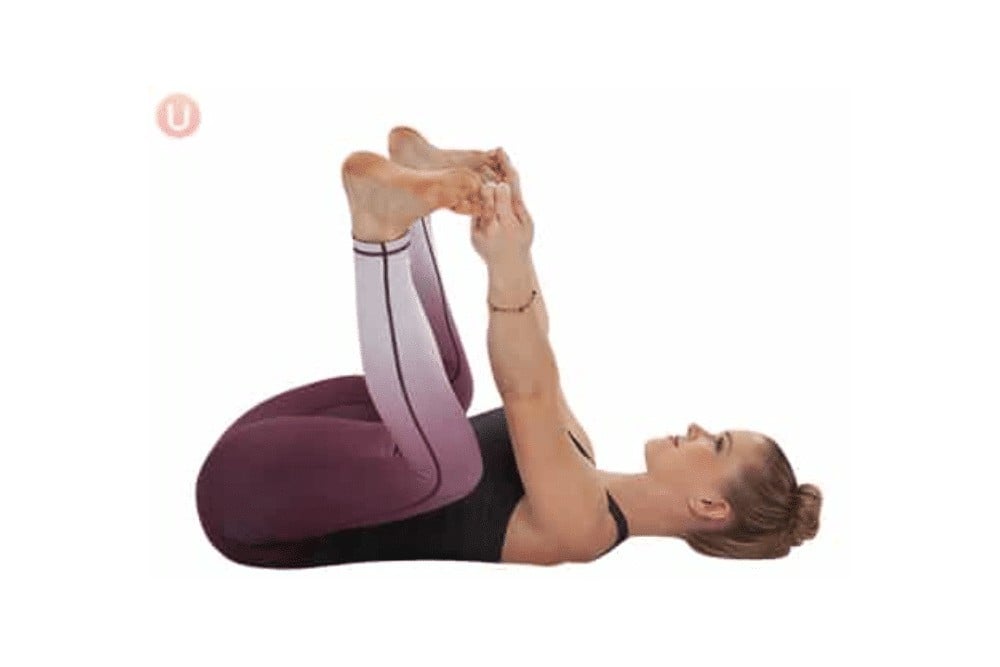
How to Perform Happy Baby Pose
- Begin lying on your back and grab your big toes with your index and middle fingers.
- Gently draw toes down so knee pull toward shoulders. Keep elbows gently pressing knees open.
- Relax and breathe. Hold 30 seconds.



Hello Kim,
My name is Sharon. I read and enjoyed your article. I am 60 years, and I have been a lifelong health nut for over 40 years.
The biggest problem I have with being healthy is heredity. I have inherited some things that I don’t want.
Thanks for sharing, and Thanks for your time,
Sharon
EXCELLENT PIECE OF INFORMATION. BEST OF LUCK
Great post! very detailed and all the information I needed was provided. Thanks!
Thank so much. Great info. Put me at peace so that I’m not anxious about beginning. Awesome advice! Keep writing, 😊!
Thanks for this! Any chance it could be made into a 1 page document that could be printed? I’d like to keep this on my side table to remind me to do them everyday.
well – we stopped making 1 page printables a while ago because no one was downloading them. I like the idea – but don’t have that tech at the time 😉
I get all those everyday on my yoga app! It amazing